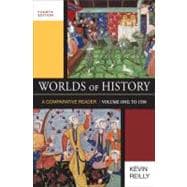Compiled by a widely respected world historian and community college teacher, Worlds of History fosters historical thinking through thematic comparisons of primary and secondary sources from around the world. Each chapter takes up a major theme — such as patriarchy, love and marriage, or globalization — as experienced by two or more cultures. "Thinking Historically" exercises build students’ capacity to analyze and interpret sources one skill at a time. This flexible framework accommodates a variety of approaches to teaching world history. The latest edition offers a broader range of sources with an even more global perspective.
"Students find the comparative approach to history dynamic, mind-opening, and fun. Reilly’s selection of documents exposes students to some of the major scholarship in the field of world history and challenges them to analyze direct evidence from the past to make historical conclusions of their own."- Eric Martin, Lewis-Clark State College








